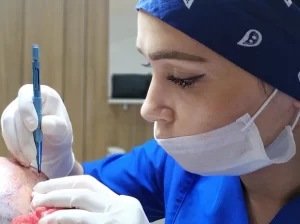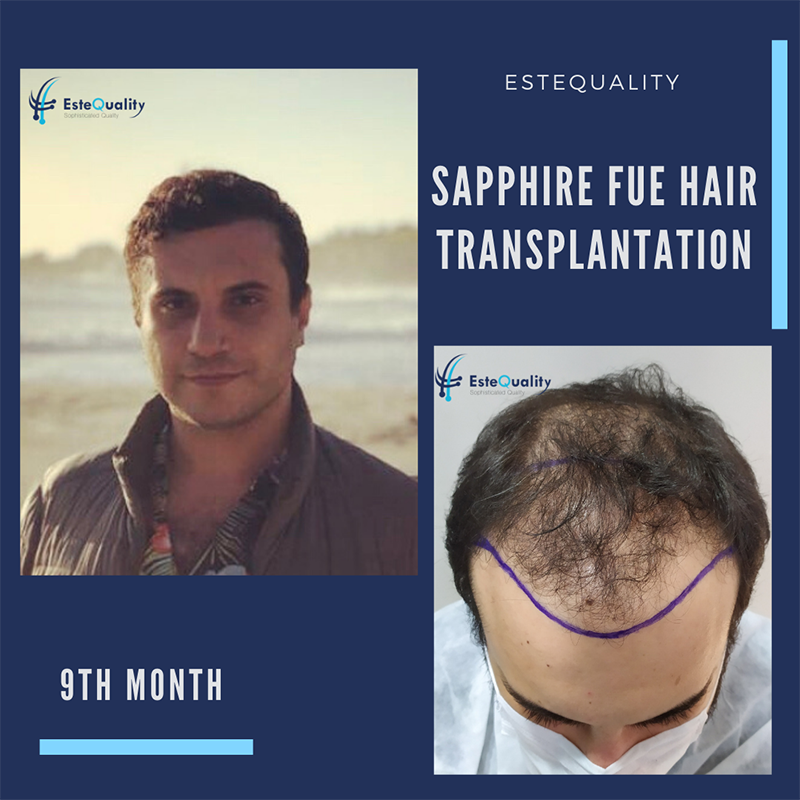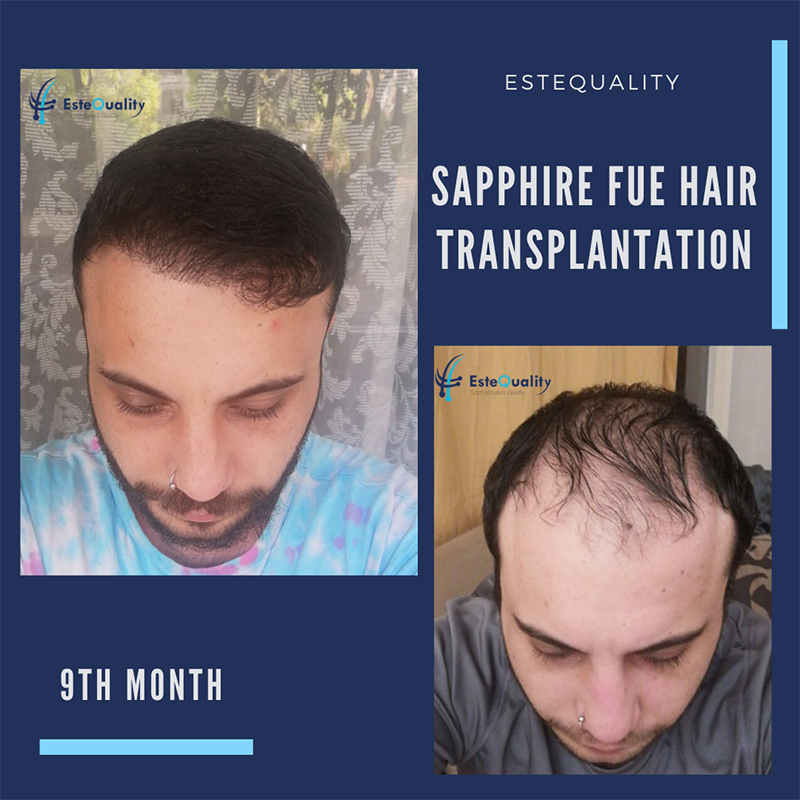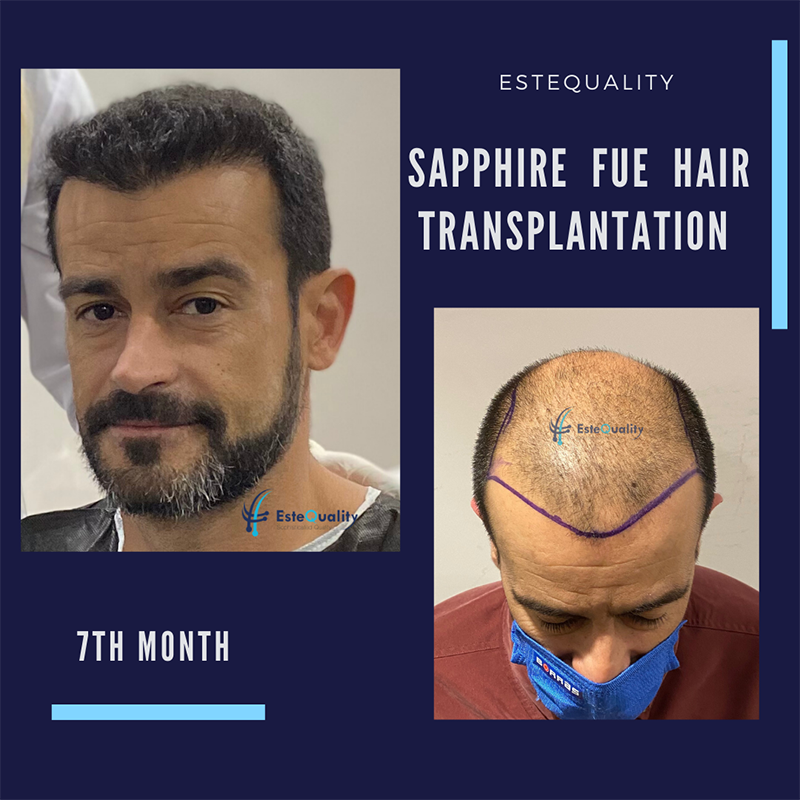Sapphire FUE Hair Transplant causes minimal damage to the scalp and allows for more dense transplantation per square centimeter.
What is Sapphire FUE Hair Transplant?
Sapphire FUE Hair Transplant refers to a technique in which the incisions or channels made in the scalp for graft implantation are done with a sapphire blade. If the channels are made with a regular medical blade, it is referred to as FUE; when a sapphire blade is used, it is known as Sapphire FUE. This method allows for more precise incisions, resulting in minimal tissue damage and enabling a denser placement of grafts in the recipient area.

Sapphire FUE Hair Transplant Surgery
Sapphire FUE Hair Transplant Surgery consists of three stages: extraction, channel creation, and implantation.
Before diving into the details, it’s important to understand a few key terms used in the industry:
- Graft: A tissue unit that contains hair follicles. A single graft may contain one, two, three, or even four hair follicles. For example, if a doctor estimates that 4,000 grafts will be transplanted, this means approximately 8,000 hair strands will be implanted.
- Donor Area: The region from which the grafts are harvested. This typically extends from one ear, across the back of the head, to the other ear.
Step 1: Extraction
In the first stage of the Sapphire FUE procedure, grafts are individually harvested from the donor area using a micro motor tool. These grafts are collected in a special solution to maintain their vitality. During the extraction process, the diameter and depth of each graft are carefully calculated to ensure minimal damage to the surrounding tissue. The most important factor during extraction is to ensure that grafts are taken evenly across the donor area. If more grafts are taken from one spot and fewer from another, the donor area may appear uneven, with one part looking sparse and another dense.
Step 2: Channel Creation
Once the extraction is complete, the channel creation process begins. In this stage, small incisions or “channels” are made in the recipient area where the hair will be transplanted. These channels are created using a pen-like tool with a sapphire-tipped blade. This sapphire blade is incredibly precise, allowing for finer incisions. It sets the direction and density of the implanted hair, ensuring the most natural-looking results.
Sapphire FUE hair transplantation minimizes damage to the scalp, leading to a faster recovery process after surgery and a more natural appearance of the hair.
Step 3: Implantation
After the channel creation phase, the final step of the surgery—graft implantation—takes place. In this stage, the harvested grafts are meticulously placed into the channels, completing the procedure.
With the Sapphire FUE technique, both shaven and unshaven hair transplantation can be performed.
Additionally, Sapphire FUE or FUE allows for a greater number of grafts to be transplanted compared to the DHI technique. This is because, in the DHI method, a single doctor is responsible for both opening channels and implanting the grafts simultaneously. In contrast, with the FUE technique, the doctor opens the channels, and then two or three nurses assist with the graft implantation. This allows for a quicker process and a larger number of grafts to be transplanted in a shorter time.
To find out if you are a suitable candidate for hair transplantation using the Sapphire FUE technique, you can call us or send your photos to our medical consultants via WhatsApp. Our consultants will have your photos reviewed by our doctors and will respond shortly, answering all your questions about the procedure.
Additionally, if you are considering coming from another city or from abroad, you can check our packages page for more information.

Sapphire FUE Hair Transplant: Before and After
Before Sapphire FUE Hair Transplant
Here are the steps that should be followed prior to a Sapphire FUE hair transplant:
- Avoid alcohol and blood-thinning medications for at least one week before the procedure.
- If you are on any regular medications, make sure to inform your medical consultant or doctor beforehand (do not start or stop any medication without their approval).
- Stop smoking and using tobacco products one week before the surgery.
- Refrain from exercise for at least a week before the procedure.
- After deciding to undergo the surgery, send photos of your hair for assessment to determine if you are a suitable candidate for Sapphire FUE. Do not cut your hair without consulting the doctor or medical advisor.
- Limit tea consumption to one cup the day before the surgery, and avoid coffee or green tea altogether.
- On the day of the surgery, you can have breakfast before heading to the clinic/hospital. If sedation is required, do not eat or drink anything after midnight the night before the surgery. Lunch will be provided during the procedure.
- Since the procedure takes approximately 7 hours, avoid wearing strong-smelling perfumes.
- Wear or bring clothing with zippers or buttons, as putting on and removing clothes over the head could damage the treated area after surgery.
To achieve the best results from Sapphire FUE hair transplantation, it is essential to follow these pre-surgery guidelines carefully.
After Sapphire FUE Hair Transplant
Here are the steps to follow after Sapphire FUE hair transplantation:
- Use the prescribed medications exactly as directed.
- On the first night, sleep on your back, as there may be slight leakage from the bandage applied to the donor area. Wrap a pad around the neck pillow provided after the surgery to protect your regular pillow from any fluid or blood stains. If you notice any bleeding, inform your medical consultant.
- After the procedure, fluid injected beneath the scalp to protect the capillaries may take about four days to fully exit the body. This fluid will be expelled through sweat, urine, and the open pores in the donor area. During this time, rest as much as possible and keep your head elevated at a 45-degree angle. Avoid bending your head forward and drink about three liters of water per day. Failure to follow these instructions may result in fluid accumulation near the forehead or eyes, which, while harmless, can be aesthetically bothersome.
- Use the neck pillow to support your head when sleeping, and avoid sleeping on your side or stomach. Follow your medical consultant’s instructions on using the neck pillow.
- For the first ten days, take extra care to avoid bumping or rubbing the transplanted area (while getting in and out of cars, changing clothes, sleeping, etc.).
- Avoid salty foods for the first five days after surgery.
- Throughout the healing process and beyond, avoid scratching the scalp with your nails, even in areas not involved in the surgery. For the first 10 days, you may only gently touch itchy areas without rubbing, and after 10 days, you can massage the scalp in circular motions using your fingertips.
- Refrain from wearing a hat or similar headgear during the first 10 days.
- Avoid sexual activity for three days after surgery.
- Refrain from consuming alcohol or smoking for 10 days after the procedure.
- Avoid swimming, saunas, steam baths, sunbeds, or strenuous physical activities (such as weightlifting or contact sports) for 15 days, or until your wounds are fully healed. Strenuous activities should only be resumed one month after the surgery.
- The donor area can be trimmed with a hair clipper 30 days after surgery. However, for six months, avoid pressing the clipper too hard against the scalp. The recipient area can only be trimmed with scissors three months after the procedure. Do not use razors or straight blades for at least a year, and if possible, avoid using them entirely.
- You can dye your hair four months after the procedure if using herbal hair dye, and six months after if using regular dye.
- Numbness and itching in the treated areas may continue for up to six months.
- One month after Sapphire FUE hair transplantation, some or all of the transplanted hair may shed, but it will begin to grow again within 3-4 months. Full results will be visible after approximately one year, so it’s important to send monthly photos to your medical consultant for follow-up during the recovery process.
At EsteQuality, our hair transplant surgeries are guaranteed. If the transplanted hair does not grow as expected due to reasons related to the doctor, we offer a free revision. However, this situation is extremely rare, occurring in only about one in a thousand cases.
To further strengthen your hair growth, enhance hair quality, and nourish your scalp, you can explore supportive treatments such as vitamin supplements, stem cell therapy, mesotherapy, and PRP treatments by contacting your medical consultant.
The sapphire blade has antibacterial properties and causes less damage to capillaries compared to traditional medical blades, allowing for better circulation in the scalp. Another advantage of the Sapphire FUE technique is that it allows for the transplantation of more grafts per square centimeter, resulting in denser hair. Lastly, Sapphire FUE can be performed with both shaven and unshaven hair.
Sapphire FUE Hair Transplant Reviews
Those Who Undergo Sapphire FUE Hair Transplant Are Extremely Satisfied with the Results. The primary reason is the remarkable transformation in their appearance.
Many individuals who start losing hair during adolescence hardly remember themselves with a full head of hair. Around nine months after the hair transplant procedure, they experience a significant change, leading to an extraordinary boost in confidence and a fresh start in life. Furthermore, this newfound confidence often results in life changes, with many single individuals getting married just a few years after the transplant. In fact, unless they choose to share it, even their partners may not realize they had a hair transplant.
At EsteQuality, which prioritizes natural results, both the donor and recipient areas are treated so carefully that it becomes virtually impossible to detect the procedure. The most crucial area for achieving a natural look is the frontal hairline. The new hairline should never be designed the same for everyone; it must be personalized, taking into account the unique facial structure of each individual. To ensure a natural look in the donor area, grafts should be extracted evenly across the back of the scalp. If the area behind the ears is thinner while the back of the head is denser, fewer grafts should be taken from behind the ears and more from the back, creating a balanced appearance.
Istanbul has become the global capital for hair transplantation, and the satisfaction of those who undergo Sapphire FUE hair transplants in Turkey is a testament to this. One of the main reasons for Istanbul’s leadership in this field is the ability to transplant more grafts in a single surgery compared to other countries. While an average of 3,000 grafts are transplanted in other countries, Istanbul typically sees 6,000 grafts transplanted in one session, with numbers reaching as high as 7,500 grafts. Remarkably, more than 95% of the transplanted hair takes root.
For instance, we performed a 7,000 graft hair transplant for Mustafa Bey in just one surgery. He noted, “The procedure changed my appearance so much that I had to update my identification photo.” As you can see in the photo, the result is stunning! This exceptional transformation didn’t just happen during the surgery. Our medical consultants stayed in constant contact with him post-surgery, offering guidance on what to do and what to avoid until his hair fully grew in.
All of our guests, like Mustafa Bey, who have chosen EsteQuality are consistently satisfied with the results. The key reason is that EsteQuality offers real results, not just hope. Thanks to our experienced doctors, who have performed thousands of surgeries, we can accurately predict how the hair will look post-surgery based on its current condition.
In conclusion, those who undergo Sapphire FUE hair transplant are extremely pleased with the outcome and report that this change positively impacts their lives. At EsteQuality, we provide our guests with the guarantee, “You will look even better than you do now!”
Sapphire FUE Hair Transplant Cost Turkey 2025
The Sapphire FUE hair transplant cost Turkey 2025 continue to be significantly more affordable compared to other countries.

The costs in the table above only refer to the surgery cost (They are not all-inclusive package cost.).
Let’s break it down with an example:
In conclusion, Sapphire FUE hair transplant cost Turkey 2025 remain not only more affordable but also of higher quality compared to other countries. Particularly for men seeking cosmetic surgery, it’s essential to thoroughly research clinics and choose one that offers reasonable prices, rather than just going for the cheapest option.
To find out if you are a suitable candidate for hair transplantation using the Sapphire FUE technique, you can call us or send your photos to our medical consultants via WhatsApp. Our consultants will have your photos reviewed by our doctors and will respond shortly, answering all your questions about the procedure.
Additionally, if you are considering coming from another city or from abroad, you can check our packages page for more information.

Operation Time
7 Hours

Anesthesia
Local Anesthesia
Needle-Free Anesthesia
Sedation

Sensitivity process
3 Days

Return to work
3 Days

Healing process
12 Days

Hospitalization
None
FREQUENTLY ASKED QUESTIONS
How many types of anesthesia techniques for Sapphire Fue hair transplant are there?
There are 3 types of anesthesia techniques. Local anesthesia, Needle-Free Anesthesia and Sedation.
Local anesthesia is injected with standard needles, and anesthesia is performed on average in five minutes. Afterward, the injected area becomes completely numb. Thus, you will not have pain during and after the operation.
Pain Duration: Average of 5 minutes
Needle-Free Anesthesia is a device that gives anesthesia for the area of the operation by pressure, not by needles. After the site is entirely anesthetized, anesthesia is continued with a needle, and the person does not feel it.
We use this device only in the area where we take the grafts (donor area). Because some bruising occurs after the pressure in the using area, we do not use it in the transplant area.
Needle-free anesthesia is an ideal solution for people with needle phobia.
Pain Duration: Average of 3 minutes
Sedation is when sedative drugs are given before the surgery, and it helps you feel more relaxed during the operation. The anesthesiologist injects the sedative drugs into your vein. You don’t feel pain, but you don’t sleep, either. So you will be able to answer the questions asked. In addition, you will be slumberous during the surgery.
Pain Duration: Painless
Who is Suitable for Sapphire FUE Hair Transplant?
Sapphire FUE hair transplant is suitable for both men and women who have experienced total hair loss or have significant hair loss in specific areas. The procedure is ideal for individuals who are generally between the ages of 18 and 70, as hair transplant surgery is not recommended for those under 18 or over 70 years old. Factors such as the patient’s overall health, hair loss pattern, and the quality of the donor area are also considered when determining eligibility for the procedure.
What Decisions Should Be Made Before a Hair Transplant Procedure?
Before undergoing a hair transplant procedure, several key decisions need to be made:
- Choosing the technique: It’s important to decide which hair transplant method is suitable, such as Sapphire FUE or DHI.
- Anesthesia options: You’ll need to decide whether the procedure will be performed under local anesthesia, needle-free anesthesia, or sedation.
- Shaven or unshaven transplant: It’s crucial to determine whether the procedure will be done with shaven or unshaven hair, depending on the desired outcome and personal preference.
These decisions are typically made in consultation with your doctor, who will guide you based on your hair condition and overall goals.
What Are the Advantages of the Sapphire FUE Technique?
The Sapphire FUE technique offers several advantages, particularly in the canal-opening process:
- Minimized tissue damage: Unlike traditional steel slits, sapphire blades allow for smoother and sharper incisions. This results in less trauma to the scalp, which helps preserve capillary networks that feed the hair grafts, thus improving graft survival and quality.
- Faster healing process: The precision of sapphire blades ensures less damage to the skin, leading to a quicker recovery. The smoother incisions reduce tissue disruption, speeding up the healing process post-operation.
- Higher density: One of the key advantages of the Sapphire FUE technique is the ability to implant more grafts per square centimeter. The sharpness and fine nature of the sapphire blade allow for denser hair placement, providing a fuller and more natural look.
These benefits make Sapphire FUE a superior option for those seeking a minimally invasive, highly precise, and effective hair transplant procedure.















